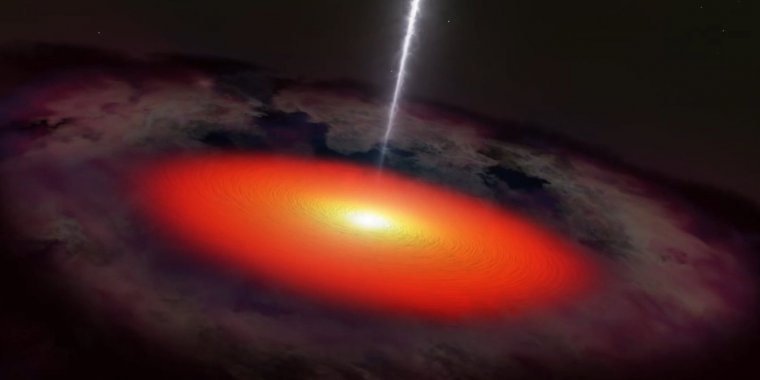| News / Space News |
NASA’s Fermi Traces Source of Cosmic Neutrino to Monster Black Hole
For the first time ever, scientists using NASA’s Fermi Gamma-ray Space Telescope have found the source of a high-energy neutrino from outside our galaxy. This neutrino traveled 3.7 billion years at almost the speed of light before being detected on Earth. This is farther than any other neutrino whose origin scientists can identify.

The discovery of a high-energy neutrino sent astronomers on a chase to locate its source—a supermassive black hole in a distant galaxy. Credits: NASA’s Goddard Space Flight Center
High-energy neutrinos are hard-to-catch particles that scientists think are created by the most powerful events in the cosmos, such as galaxy mergers and material falling onto supermassive black holes. They travel at speeds just shy of the speed of light and rarely interact with other matter, allowing them to travel unimpeded across distances of billions of light-years.
Scientists study neutrinos, as well as cosmic rays and gamma rays, to understand what is going on in turbulent cosmic environments such as supernovas, black holes and stars.
Neutrinos show the complex processes that occur inside the environment, and cosmic rays show the force and speed of violent activity. But, scientists rely on gamma rays, the most energetic form of light, to brightly flag what cosmic source is producing these neutrinos and cosmic rays.
On Sept. 22, 2017, scientists using IceCube detected signs of a neutrino striking the Antarctic ice with energy of about 300 trillion electron volts—more than 45 times the energy achievable in the most powerful particle accelerator on Earth. This high energy strongly suggested that the neutrino had to be from beyond our solar system.
Backtracking the path through IceCube indicated where in the sky the neutrino came from, and automated alerts notified astronomers around the globe to search this region for flares or outbursts that could be associated with the event.
Data from Fermi’s Large Area Telescope revealed enhanced gamma-ray emission from a well-known active galaxy at the time the neutrino arrived.
This is a type of active galaxy called a blazar, with a supermassive black hole with millions to billions of times the Sun’s mass that blasts jets of particles outward in opposite directions at nearly the speed of light. Blazars are especially bright and active because one of these jets happens to point almost directly toward Earth. (NASA)
YOU MAY ALSO LIKE
